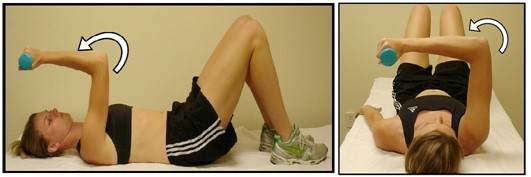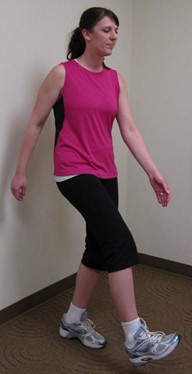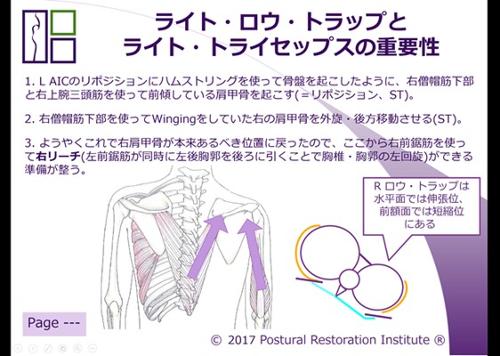Our right triceps become very challenged if we can not sufficiently engage our left internal obliques and transverse abdominals during active late left lower extremity ‘push-off’ and concomitant active late right upper extremity ‘push-back’ (shoulder extension). Our bodies lose their ability to become centered over the left when our left abdominals, left hamstrings and right triceps disengage as a functional group. A few weeks ago Sy Abe-Hiraishi, a PRI faculty member, asked me about a non-manual technique called the ‘Supine Weighted Tricep Curl’ and the reasoning behind the two methods of instruction. I absolutely loved the question, the dialogue and the timing, since I will be presenting information on group function afferentation at this year’s Spring Symposium. Please read her summary and the response that is presented from a question that was initially asked by a course attendee that attended one of her courses in Japan. So awesome!
Gratefully, Ron
アメリカの皆さんこんにちは!
Hello everyone!
日本講習担当、PRI講師の阿部さゆりです。昨年の12月に日本で初めてポスチュラル講習の開催をすることができたのですが、その際に参加者さんから出た質問とその答えを今日はここで共有したいと思っています。ロンが日本語と英語の両方でアップして!というので、両方でお届けしますですよ。
This is me, Sy writing this blog post – those of you who do not know me, I am one of the two PRI faculty members that are designated to teach courses in Japan. We hosted our very first Postural Respiration courses in Japan in December, and this interesting question came up from a participant. Today I am hoping to share the question and answer with y’all…(in case you cannot tell, I currently live in Texas). Ron specifically requested that I post this both in Japanese and English, so here it is – hope y’all enjoy!
ポスチュラル講習では左のハムストリングを使って骨盤を起こすように、右のトライセップスを使って右肩甲骨を起こすことがいかに重要か、という話をしますよね。その流れで講習中スーパイン・ウェイテッド・トライセップス・カールズの解説と実技ラボをおこなったのですが、このエクササイズにはやり方が二通り(ポジションA vs B)あり、「このエクササイズのポジションの違いは何?どういう状況の場合、どちらを選ぶのが正解なの?」という質問が日本人参加者さんから出たのです。
In Postural, we learn to use the Right Triceps to “get the scapular up” just like we learn use our Left Hamstring to “get the pelvis up” in the Myokin course. One of the exercises we demonstrated and practiced in our Postural courses in Japan was “Supine Weighted Triceps Curls,” and that’s when this question was brought up – “I see, in the manual, that this exercise can be performed in two different positions – the original (Position A) and the alternate (Position B). What is the difference and what are some of the reasons we should pick one over the other?”

Position A Position B
What a great question! This got Ron super-excited because no one in the U.S. ever asked this question to him, and Ron and I had a great conversation about it over lunch the other day. So let me first share the short version of the answer – “You should always try Position A first. If it does not work, try Position B as this should be the “mechanically advantaged” version of the same exercise.”
最初に答えを書いてしまうと、どんな患者相手にもまず試すはポジションAです。このポジションでは、歩行時に左足で身体を前に押し出して、右手を前・上方に振り切った状態(=右立脚中期)からエクササイズが始まるんだ、とイメージするとわかりやすいかも知れません。ここからPropel (前進)するために次にすべきは右腕を振り下ろし、後方に振り切ることですよね。同時に左腕も前に振り上げれば、体幹の右回旋・骨盤の左回旋と一緒に右足のpush-offが起こり、左前方への体重移行が可能になります。
平たく言えば、トライセップス・カールズはこの右腕の「振り下ろし始め」を練習するエクササイズなのです。エクササイズ開始時のポジションでは右肘と右肩は共に屈曲位にあり、上腕三頭筋をisolate(隔離)するのに最適と言えます。肘と肩、両関節で伸長位に置かれたこの筋肉を、肘伸展を通じて収縮させることで「腕の振り始め」に真っ先に上腕三頭筋にスイッチを入れる感覚を体得できた人は、そのあとの「右腕の後方振り切り」はモーメンタムと広背筋らの協力を得て比較的楽に、自然とおこなえるんだということに気が付くかもしれません。
And here’s the longer-version of the answer. Everything we do can be applied into various phases of the gait – so please picture yourself being in the right mid-stance. Your L AIC pushed you over to the right, you are feeling the right heel and the right mid-foot, and you just finished swinging your right arm all the way forward. Now look at Position A – both right shoulder and elbow are flexed – doesn’t it look awfully similar? If you are thinking this position is mimicking the I-just-finished-swinging-my-right-arm-forward phase, you are absolutely right!
Now think what needs to happen next. You will need to begin swinging your right arm towards the back as you start to prepare yourself for the push-off phase, and eventually to shift your body weight to the left. The initiation of the right arm swing is essential because, without this, your right arm won’t be pulled all the way back, your right trunk won’t be pulled back, and the right trunk rotation won’t occur. Combined with L AF IR, the back-swing of the right arm is the key for the upper and lower body integration as shown in the picture below.
 (89) Left Stance Interrupted Swing
(89) Left Stance Interrupted Swing
**改めて言及しますが、右の腕を後ろに引く、ということはロンがどの講習でも何度も繰り返し強調する、超超超超超重要事項です。右の腕を後方に振り切るということは右の体幹を後ろに引く、つまりは体幹が右に回旋するということでもあります(例: 下の写真参照)。体幹の右回旋は骨盤の左回旋(L AF IR)と対になるべきPRI介入には欠かせない要素です。ロン曰く、「左スタンス時(下写真)に荷重されていなければならない肢がふたつある。なんだかわかるかい?左足と、右腕だよ!」。歩行時に腕を荷重だなんて、その表現の仕方がまたロンらしいですけれど、つまるところ彼は空間把握や自我確立を導く神経的道具として、この状況では左足右腕が真価を発揮しているべきだと言いたいのです。
And hence the beauty of this exercise. Triceps curls in this position (Position A) is a great way for us to practice the initiation of the right arm swing. In this position, the triceps are elongated through the combination of shoulder flexion and elbow flexion and can be effectively isolated isolate.
しかし、このポジションで陥りやすいワナは「非常に矢状面に特化したエクササイズであり、上腕の屈曲には腰椎の伸展も伴いやすい」という点です。PRIの基本は適切なポジションで適切な筋肉を使う練習をするところですよね、ですから、患者さんがもしこのエクササイズで呼気(state of exhalation)のポジション、つまり胸郭の屈曲を保てなければ次はAlternate Position(代わりとなるポジション)であるポジションBを試すべきです。
However, here’s a pitfall of “Position A.” Because performing triceps curls in this position promotes sagittal movements, some patients just cannot help but extend their back. Those individuals weren’t quite ready to truly isolate the triceps and may need to take a step back – and try the alternate position, Position B.
ポジションBでは同じ歩行は歩行でも腕を縦ではなく横に振りながら、水平面で胴体を回旋させながら歩行してるイメージです。右の腕をぶん、と横にスイングし前に持ってきたようなこのポジションでは腰椎の伸展は格段に起こりにくいばかりでなく、体幹の左回旋が促進され、左腹壁の活性化と左後方縦郭の拡張、そして右肩甲骨の安定が起こりやすいのが特徴です。つまり、こちら(ポジションB)のほうが上腕三頭筋を単独で活性化させる(ポジションA)前に、腹壁・胸郭・肩甲骨と腕との統合をまずマスターしなければいけない患者に適したエクササイズなのです。
So now look at Position B. You also see the same gait phase in Position B, but the arm is swung to the side (on the transverse plane) instead of up to the front (on the sagittal plane). This arm position promotes the trunk rotation to the left, the better left abdominal engagement and the right scapular stabilization on the thorax, which further secures the right triceps. In this position, the patient will be given the mechanical advantage to remain in the state of exhalation (and thus not to extend the back) while activating the right triceps.
要約すると、「右上腕三頭筋の活性化にトライセップスカールを用いる場合、最初はポジションAで、もし腰椎の伸展がどうしても起こってしまう場合はポジションBでこのエクササイズをおこなう」ということです。こんな話をロンとしていたら、「こんな質問、アメリカでは受けたことないよ!」と非常にうれしがっていました。日本の方の思考力の助けを得ながら、これからも日本での講習でPRIコンセプトをこれでもかというほど切り刻んでいきたいと思います。アメリカの皆さんもこの回答を楽しんでいただければ幸いです。
Let me summarize it – “When using triceps curls to facilitate the activation of the right triceps, anyone should try Position A first. If the patient extends the back in this position, try the alternate position, Position B for the better abdominal integration.” I hope that this answer helps y’all, PRI families in both Japan and the U.S.!
追記ですが、ロンに日本のPRI講習で使っているスライドを見せたら「なにこれ!すごいねすごいね、これも一緒にアップしてよね!」と興奮して大騒ぎされてしまったので、私たちが日本ポスチュラル講習で使ったスライドの写真もおまけに付けておきます。アメリカの皆さんにも、PRIを日本語に訳すのがどれだけ大変だったか、これを見れば少しだけわかっていただけますでしょうか?
P.S. – I showed this (power point slides that we used in Japan) to Ron and he told me I HAVE to post this photo in this blog. I created some visuals and added them to the slide explaining the importance of the right low trap and right triceps…well, I am sure y’all can read the rest ;) We will continue to strive to teach high-quality, full-of-fun PRI courses in Japan!

Circle Explanation: That’s the cross-sectional view of the R BC-patterned chest….L lungs are more inflated than R, and the sternum tipped to the R. Orange semi-circles in this diagram represent SAs, and the light-blue lines are the lower traps. I use this diagram to explain how "L SA is rounded yet elongated (= challenged)" and "R SA is shortened yet flattened (= also challenged)" – sort of like obturator internus. Also, this diagram may help visualize how low traps are positioned in the transverse plane. For example, R low trap is shortened in the frontal plane (as shown in the image on the left…the back view), yet it is actually elongated in the transverse plane if you are to take a look at the image on the right (light-blue line)…the opposite is true for the L low trap… and therefore, again, both lower traps are challenged in its own way.
—
阿部さゆり
Sayuri "Sy" Abe-Hiraishi, MS, ATC/L, CSCS, PRT, NASM-PES, CES

